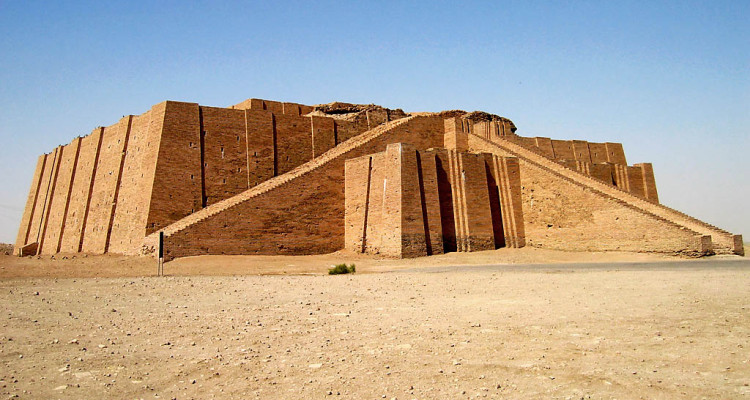The presence of temples as places where people nourish their faith and religion has existed for centuries since the beginning of the earliest civilizations. Since their foundations, temples of any religion have represented places where people could find spiritual and religious comfort. Besides this main function, temples have also played important roles in the management of their cities, impacting their societies in significant ways.

Temples in Ancient Mesopotamia, better known as “community temples,” were basically operated by priests and priestesses that were often younger relatives of the rulers. Their main role was to intervene with the gods for the fortune of their communities through prayers and offerings to their deities. In exchange, the community provided priests with food, drink, and clothing.1 Each temple was dedicated to a major deity, who was the main god of the city. Often the priests serving the temple might have been the former governor of that particular city-state.2 Like many religious organizations today, temple communities also provided help to the people in the community when in need. Temples, for example, used to take care of orphans, supply grain in time of famine, and provide ransom for people who might be captured in battle.3
Mesopotamian temples were not places where people particularly went to worship. They were thought to be the home of the city deity, and for this reason they were equipped like households. They were built with kitchens, tables (in the form of altars), living rooms, and the most important of the rooms, an inner sanctuary where a statue of the major deity stood in one of the building’s walls. Often, these temples used to have staircases to the roof, where rituals and offerings to the deity were performed (e.g. animal sacrifice to feed their god).4

Rams, sheep and doves used to be sacrificed to feed the gods. | Courtesy of National Geographic Spain
In hindsight, the role of temple communities was not limited to the city’s religious life, but they were also large socio-economic organizations.5 Temple communities in Mesopotamia also had an influence in the economy and social living of the cities. Among many of their functions, the operation and maintenance of irrigation systems was one of their highest priorities. They also controlled and managed the industry while developing and manufacturing products that later would be exchanged in foreign trade. Along with this, temples were extensive places for storaging goods and merchandise.6 The records priests and temple staff generated were so extended that some modern economic historians developed the conclusion that the Mesopotamian economy “was dominated by the temple, giving rise to the characterization of ancient Mesopotamia as a ‘temple-state economy.’”7 This was clear to see, since temples were also in charge of the finance of the city. They were in charge of collecting taxes, administrating a system of price control, regulating interest charges, financing foreign trade and legislating all private financial transactions. They also redistributed income by granting money to those in need, and often they also made loans to private individuals.8 Temples also played a role in legal matters and in maintaining social control. Marriages were performed; priests granted divorce, registered births, and administered the law.9
For the importance of their role as a major socio-economic organization as well as their role of mediators between the gods and the city, it can be concluded that Mesopotamian temples possessed a large power among the events happening in the daily life of the individuals living in a particular city. Maybe without the temples, it might have been more difficult for the rulers of the city-states to carry out the functions that these religious organizations used to perform.
- Jerry Bentley, Herbert Ziegler, and Heather Streets Salter, Traditions & Encounters: A Brief Global History Volume 1, 4 edition (McGraw-Hill Education, 2015), 15. ↵
- Richard L. A. Sterba, “The Organization and Management of the Temple Corporations in Ancient Mesopotamia,” The Academy of Management Review 1, no. 3 (1976): 16. ↵
- Bentley, Ziegler, and Streets Salter, Traditions & Encounters: A Brief Global History Volume 1, 15. ↵
- Ronald Wallenfels, World Eras – Vol. 8, Ancient Mesopotamia (Detroit: Gale, 2004), 162. ↵
- Sterba, “The Organization and Management of the Temple Corporations in Ancient Mesopotamia,” The Academy of Management Review, 17. ↵
- Sterba, “The Organization and Management of the Temple Corporations in Ancient Mesopotamia,” The Academy of Management Review, 18. ↵
- Wallenfels, World Eras – Vol. 8, Ancient Mesopotamia, 161. ↵
- Sterba, “The Organization and Management of the Temple Corporations in Ancient Mesopotamia,” The Academy of Management Review, 19. ↵
- Sterba, “The Organization and Management of the Temple Corporations in Ancient Mesopotamia,” The Academy of Management Review, 19. ↵



61 comments
Johnanthony Hernandez
Amazing to see how the temple, like many others, were religious strong points that did much of the same things that modern places of worship do now. I did not know that about the temples in Mesopotamia, or that they were usually staffed by priest and priestess that were younger members of the ruling family. Great article, I would really like learn more about the temples in Mesopotamia and more of the socioeconomic factors that they played.
Hayden Hollinger
This was a very interesting article which I learnt a lot from. I had different perspectives of temples and was intrigued to find out that they were used for a lot more than I was initially aware of. It was cool to learn that the temples were operated by priests and priestesses. I also was fascinated to learn that the main roles of the temples were to intervene with the gods for the benefit of the communities.
Lianna Ybarra
I always thought temples were places of worship for different cultures that had them so I liked learning about how they were more of an orphanage where it was almost like a safe haven for people who didn’t have a place to go. Your article did a great job of telling where where and what they were used for and for describing the area around them, like Mesopotamia.
Bailey Rider
This was a very interesting and informative article! I didn’t know that the priests and priestesses were relatives of the rulers, which is cool to learn. I also thought it was cool to learn about how each temple was dedicated to a certain deity. It was also cool to see that the priests and priestesses helped with law making and enforcement. Thank you for the article!
Jacob Hall
Excellent job on the article. I never thought to think of how important the people who worked in the temple were, and how there role worked in the society. i find it interesting that the people would provide for the needs of the priests, so that they would intervene with the gods on behalf of the community. in a way this concept kind of reminds me of how the church works today, we give them donations and they give us the support and blessing of god.
Tina Valdez
The roles that Mesopotamian temples fulfilled were surprising. I would not have imagined that the roles temples fulfilled in that society would be so different to those that temples fulfill now. There are of course similarities between temples then and now, but temples then seemed to have fulfilled many more roles than temples today. For instance, it would be strange if churches today were in control of the entire city’s finances. Very interesting article, and very well written!
Jezel Luna
Whenever temples come to mind I automatically associate it with religious and cultural attributes. It’s interesting how the Mesopotamian temples were more like households rather than places of worship. I had no idea that the temples would have so much effect on the economy as well as the social living. Great description on the Mesopotamia temples and their meanings!
Rachel White
One thing that really stood out to me in this article was the fact that there were “priestesses.” I find this interesting because when I was a child, going to a Catholic school, it was unheard of for a woman to play any role besides that of a nun and now I learned that their were women serving as heads of the churches in ancient times. I also was aware of the religious role the temples would play, but not the socio-economic role they played as well. Very interesting topic and great, extensive list of sources.
Aylin Salinas
This is quite interesting. I always assumed that temples were for religious and cultural purposes only. Your article does a wonderful job on explaining what the temples really do and how they operate in Mesopotamia. It is very fascinating to see that they were run by “priests and priestesses that were often younger relatives of the rulers.” The temple was really the center for all socio-economic, cultural, religious, and legal purposes!
Celina Resendez
Your article is very clear and concise about the how temples functioned in Mesopotamia. I always thought they were used for nothing more than worshiping deities. It surprised me to learn that deity worship was only a small function of these temples, and they in fact had a much larger function. Reading that they were home to a lot of the “law making” and “law enforcement” type work is truly amazing. I guess one could say the temples “did it all”!